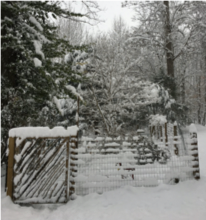This morning I’m doing something I truly love - writing. While that may not seem unusual, this is the first time since early fall, I’ve been able to put “pen to paper.” Like so many of my writer and artist friends, it’s seemed difficult, if not impossible, actually to create something. It’s not as though I’m not inspired or that I don’t think of things to write. It’s more that I cannot seem to motivate myself physically to do it. So. Writer’s block. That numbing, paralyzing, seemingly insurmountable gray feeling that causes our color-filled artistic world to stop. It happens to all of us - especially now during the pandemic. There are ways out, hard as it is, trust in that.
I’m sure it was a resilient little wren that caused my block to crack just a bit. I awoke this morning to her staring through the window, demanding to know why her breakfast birdseed was late. She literally pulled me back to my artistic senses. I suddenly realized - why not break my routine, step away from the endless, daily search for “gig work” (i.e., income that helps pay the bills…), and devote some time to something I actually enjoy? (!) Writing. So, here it is, this end-of-a-challenging-year blog entry.
Of course, while writing, I searched the web for the “why” of creative blocks. One of the prime suspects is being distracted by countless events - how can we not be distracted this year! In a way, it’s incredible that any of us can still form sentences. This year has been a tragic, debilitating time. When a “wren moment” happens, it pulls us together, brings us up from the depths, and compels us to act. Realizing there’s so much to be thankful for, I’m endeavoring to stop listening to my perfectly tuned chorus of negative voices, change my inner dialog, and get on with what I love – writing. I trust the rest will begin to fall in place. Thanks to all of you who’ve supported and read these entries this year. I’ve enjoyed writing them and plan to continue in this coming year. Wrens are small but mighty birds - their spirit and wings can help us begin to fly again. Here’s to the blessing of creative joy for each of you in the coming year!
Photo credit: Dee Stribling Creative
Supporting articles:









